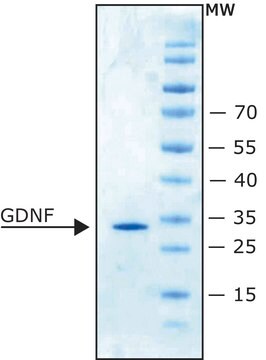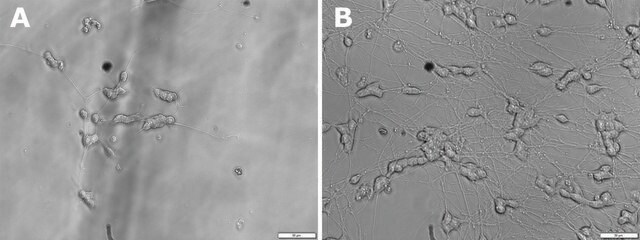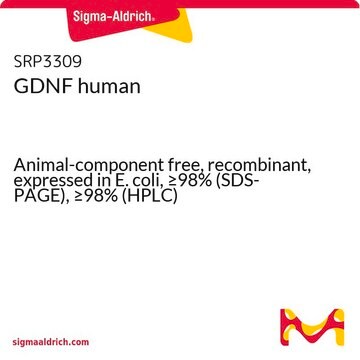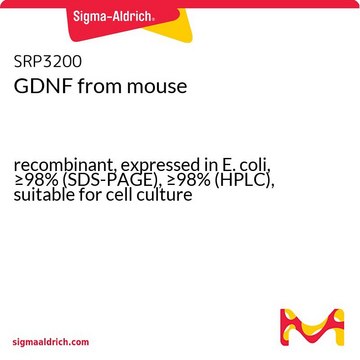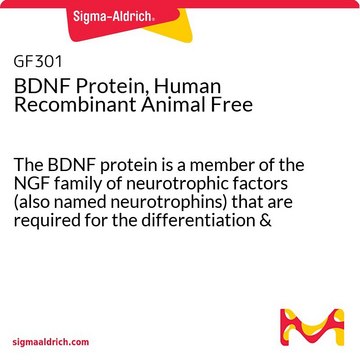GF322
GDNF, Human Recombinant
Animal Free
Sinónimos:
Glial Derived Neurotrophic Factor
Iniciar sesiónpara Ver la Fijación de precios por contrato y de la organización
About This Item
Código UNSPSC:
12352202
eCl@ss:
32160405
NACRES:
NA.77
Productos recomendados
Descripción general
GDNF is a disulfide-linked homodimeric neurotrophic factor structurally related to Artemin, Neurturin and Persephin. These proteins belong to the cysteine-knot superfamily of growth factors that assume stable dimeric protein structures. GDNF signals through a multicomponent receptor system, composed of a RET and one of the four GFRα (α1-α4) receptors. GDNF specifically promotes dopamine uptake and survival and morphological differentiation of midbrain neurons. Using Parkinson’s disease mouse model, GDNF has been shown to improve conditions such as bradykinesia, rigidity, and postural instability.
The functional human GDNF ligand is a disulfide-linked homodimer, of two 15 kDa polypeptide chains called monomers. Each monomer contains seven conserved cysteine residues, one of which (Cys 101) is used for inter-chain disulfide bridging and the others are involved in intramolecular ring formation known as the cysteine knot configuration.
The functional human GDNF ligand is a disulfide-linked homodimer, of two 15 kDa polypeptide chains called monomers. Each monomer contains seven conserved cysteine residues, one of which (Cys 101) is used for inter-chain disulfide bridging and the others are involved in intramolecular ring formation known as the cysteine knot configuration.
Product Source: Protein is expressed in E.coli.
The protein is manufactured without the use of any animal products/reagents and is considered Animal-Free and can be used in protocols where possible transmisson of animal viruses and contamination must be avoided.
The protein is manufactured without the use of any animal products/reagents and is considered Animal-Free and can be used in protocols where possible transmisson of animal viruses and contamination must be avoided.
Aplicación
Research Category
Stem Cell Research
Stem Cell Research
Research Sub Category
Growth Factors & Receptors
Growth Factors & Receptors
Calidad
The ED50 was determined by the proliferation of rat C6 cells is ≤ 0.1 µg/ml, corresponding to a specific activity of ≥ 1 x 10^5 units/mg.
Forma física
Product is presented in 10 mM Sodium Citrate + 150 mM NaCl and is filtered through a 0.2 micron filter before lyophilization.
Almacenamiento y estabilidad
Store at -20°C for up to 4 months from date of receipt Centrifuge the vial prior to opening.
Reconstitute in water to a concentration of 0.1-1.0 mg/ml. Do not vortex. For extended storage, it is recommended to further dilute in a buffer containing a carrier protein and store in working aliquots at -20°C.
Reconstitute in water to a concentration of 0.1-1.0 mg/ml. Do not vortex. For extended storage, it is recommended to further dilute in a buffer containing a carrier protein and store in working aliquots at -20°C.
Cláusula de descargo de responsabilidad
Unless otherwise stated in our catalog or other company documentation accompanying the product(s), our products are intended for research use only and are not to be used for any other purpose, which includes but is not limited to, unauthorized commercial uses, in vitro diagnostic uses, ex vivo or in vivo therapeutic uses or any type of consumption or application to humans or animals.
Palabra de señalización
Warning
Frases de peligro
Consejos de prudencia
Clasificaciones de peligro
Eye Irrit. 2
Código de clase de almacenamiento
11 - Combustible Solids
Clase de riesgo para el agua (WGK)
WGK 1
Certificados de análisis (COA)
Busque Certificados de análisis (COA) introduciendo el número de lote del producto. Los números de lote se encuentran en la etiqueta del producto después de las palabras «Lot» o «Batch»
¿Ya tiene este producto?
Encuentre la documentación para los productos que ha comprado recientemente en la Biblioteca de documentos.
Melissa Hingorani et al.
Frontiers in neuroscience, 16, 994735-994735 (2022-11-11)
Vertebrate brains have a dual structure, composed of (i) axons that can be well-captured with graph-theoretical methods and (ii) axons that form a dense matrix in which neurons with precise connections operate. A core part of this matrix is formed
Nuestro equipo de científicos tiene experiencia en todas las áreas de investigación: Ciencias de la vida, Ciencia de los materiales, Síntesis química, Cromatografía, Analítica y muchas otras.
Póngase en contacto con el Servicio técnico